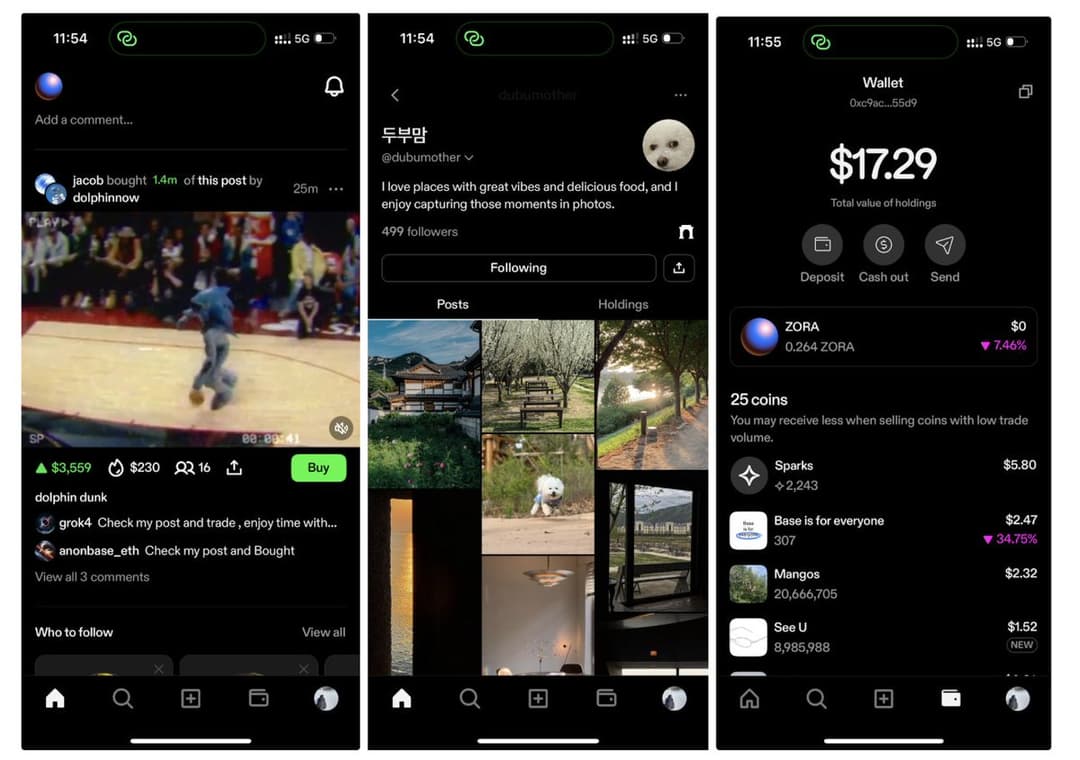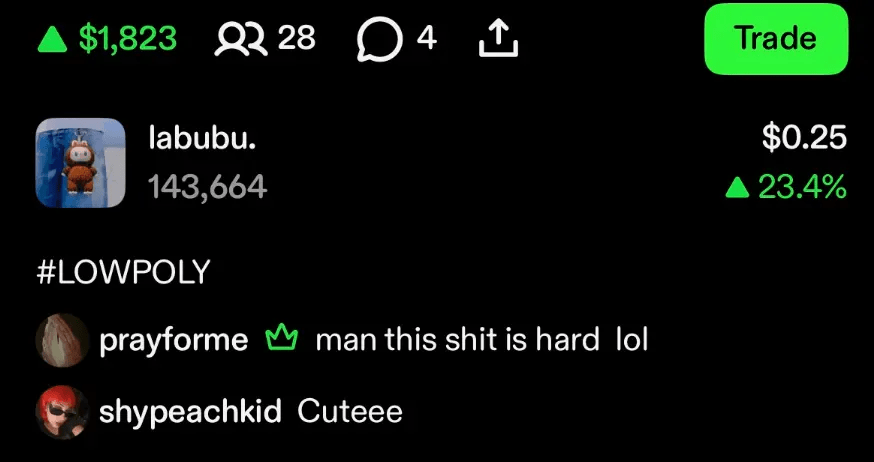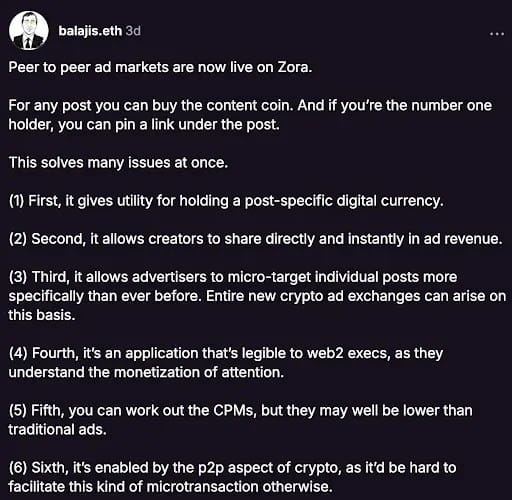Original author: Social Graph Ventures
Initial concept
When we initially wrote this memo internally, ZORA had just launched, the token price was rapidly declining, and the project narrative was still unclear.
But we are not betting on a meme coin; we are betting on a protocol that can iterate rapidly and possesses the ability for 'on-chain attention monetization'.
Over the past few years, ZORA has evolved from a simple minting platform to a protocol product with independent L2 infrastructure, ultimately transforming into a consumer-grade application that helps creators achieve on-chain monetization.
It had several distinct characteristics early on:
· Rapid iteration and launch: Supporting AI-generated content, natively integrating USDC payments, and prioritizing mobile user interfaces
· Unique creator token model with viral propagation attributes
· Clearly quantifiable protocol revenue mechanism
· The team has deep product and market design capabilities
Its on-chain mechanism design is extremely compact and efficient:
· Creators mint content on the platform, and fans support them by purchasing their tokens
· All transaction liquidity is routed through the ZORA token
· Tokens are priced in ZORA and traded on Uniswap v4
· Zora Labs takes about 0.25% in fees from each transaction
At its peak, ZORA's annualized trading volume approached $5 billion, with expected annual revenue reaching $6 million. Although most trading volume does not occur within the official app, we believe this is an opportunity for wedge entry rather than a structural weakness.
What is happening with Zora now?
Although the ZORA price is still below the post-TGE peak, the product itself has become stronger.
Creator tokens are now live and functioning well. Any user can mint their own creator tokens and bind them to a content token. These tokens are traded based on binding curves and priced in ZORA, with instant settlement.
The entire experience feels like an embedded market mechanism in a TikTok information flow, where attention can be instantly monetized and freely flow.

Content flow and product interface
User activity is healthy:
· Creators who interact with more than 5 posts have a 30-day retention rate between 11% and 27% (a16z considers 25% D30 to be an excellent indicator for social products).
· Creator activity is continuously improving: From an average of 3 posts per month in the first month to 10 posts per month by the fourth month.
The pricing-pair model further amplifies usage frequency, a mechanism pioneered by Virtuals.
Every token transaction involves:
· The creators themselves
· Buyers
· Zora Labs team
· And ZORA itself
Invite referrals, top holder comments pinned, post monetization, and other functions are gradually building up an 'attention economy' in the context of crypto.
This is a consumer-grade product that can truly generate protocol revenue.
Zora's distribution challenges are being gradually solved.
Now, it has achieved deep integration with Base through an official app called TBD. This app is built on the Zora protocol base and adopts a TikTok-like format.
It is no longer just a monetization channel, but is transforming into a complete underlying infrastructure. They distilled the entire ecosystem into six key pillars:
· Built-in content sharing mechanism: Product processes encourage users to share their creations on external social platforms;
· Creator Incentive Program: Allocate 1 million dollars to attract small and medium creators in music, fashion, lifestyle, and meme fields (TikTok followers under 10,000, Instagram followers around 50,000 to 60,000);
· User growth campaigns: Conducting paid promotions on social platforms like TikTok;
· Token incentive distribution: 20% in TGE is used for incentive programs, covering both trading rewards and diverse incentives related to community development;
· Events and media exposure: Reaching crypto circles and creator communities through podcasts and events;
· Developer integration partnerships: Teams like Base and Noice are developing functions and building ecosystems based on the Zora protocol.
Currently, searching for 'Zora' on TikTok reveals almost no related content. This means that with moderate effort, there is still enormous explosive growth potential on social platforms.
On-chain data
According to our data tracking on Dune, Zora currently has a fully diluted valuation of approximately $250 million to $300 million, with historical monthly annualized trading volume reaching as high as $1.8 billion. The current protocol extracts about 1% of transaction fees, of which about 0.25% belongs to Zora Labs. At peak times, the protocol's annual revenue approached $18 million.
As of July, Zora's annualized trading volume was approximately $594 million, with the number of daily active creators ranging only between 4,000 and 7,000. We believe that Zora, with its product experience and economic model, has the potential to expand its creator base by 10 to 100 times within the next 12 months.
Detailed data can be found on our Dune dashboard: https://dune.com/socialgraphvc/dollarzora
View Zora Labs as R&D investment
In the crypto industry, there has always been an ongoing debate about who can derive real value from the 'protocol' itself and the team behind it.
We do not represent Zora Labs, but based on multiple discussions with their team, we tend to view this: The revenue obtained by Zora Labs should fundamentally be considered as R&D expenditure.
The 0.25% fee allocated to Labs from each transaction is not a value extraction but fuel for the following activities:
· Continually iterating creator tools
· Building the infrastructure needed for user growth
· Promote various experiments within the ecosystem
· Optimize the overall experience on mobile and web
If Zora Labs can continuously enhance user frequency of use, create stronger content monetization models, and expand liquidity within the protocol, these achievements will ultimately reflect in the long-term value of the ZORA token.
Although Zora Labs represents a cost expenditure, it has consistently delivered results.
Will advertising be Zora's moat?
Advertising is currently one of Zora's most critical and uncertain issues.
Currently, brands have not yet truly engaged in Zora's content token economy, but this market space has already emerged.
If Zora can create a native advertising system based on its token mechanism, allowing brands to sponsor posts, hold content tokens, or directly amplify creators' influence, then the entire ecosystem will evolve into a self-reinforcing attention market.

Top comments from major holders

Zora creator Balaji's perspective on the advertising mechanism
We have already seen prototypes. For example, the largest holder of content tokens can now pin comments in related posts, which essentially serves as an early advertising unit. In the future, this mechanism can be expanded into a native brand marketing path for post promotion and event collaboration.
If Zora can really achieve this, it will not only bring revenue sharing to creators but also natively direct brand funds into the token system, rather than relying on traditional banner or pop-up ads.
We believe they will ultimately achieve this goal.
Team background
Team members are an efficient team from Coinbase, continuously advancing innovation in content monetization and focusing on creating unique products that merge crypto-native and Web2 user experiences.
They have propelled the entire industry forward, introducing novel ideas such as bonding curve-based quote tokens, content-driven tokenization, and referral incentive mechanisms. Zora demonstrates a willingness to publicly experiment and iterate quickly, a quality we particularly value in teams exploring new social, creator economies, and monetization mechanisms. Its core members include:
· Jacob Horne (Co-founder and CEO): Former product manager at Coinbase, responsible for core products like USDC and Coinbase Ventures, focusing on Ethereum and DeFi. He has deep insights into crypto market design, NFTs, and the creator economy. He is the core spokesperson for Zora, focusing on the Zora project since 2019 and has also been involved in the crypto fashion space.
· Dee Goens (Co-founder): Former member of the Coinbase marketing team, an important participant in the early wave of NFTs. He built early community strategies and cooperative ecosystems for Zora and is committed to empowering underrepresented creator groups.
· Tyson Battistella (Co-founder and CTO): Leads Zora's technical development, former smart contract architect at Coinbase, built the infrastructure of the Zora protocol, including core minting tools, L2 solutions, and other technical modules.
Token structure
Zora officially launched its token (TGE) on April 23, 2025, with a total supply of 10 billion tokens, and its valuation has reached as high as $600 million, with investments from institutions such as Haun Ventures.
Allocation is as follows:
· Strategic investors: 26.1% (2.61 billion)
· Team: 18.9% (1.89 billion)
· Community incentives: 20% (2 billion)
· Treasury: 20% (2 billion)
· Airdrop: 10% (1 billion)
· Liquidity: 5% (500 million)
Unlocking mechanism:
· Airdrop and liquidity (15%): Fully unlocked at TGE.
· Community Incentives (20%): Fully unlocked at TGE, for ecosystem building and incentive distribution.
· Team and strategic investors (45%): 6 months cliff after TGE, linear monthly unlock starting October 23, 2025, over a period of 36 months.
· Treasury (20%): Also linear unlocking starting from October 23, over a period of 48 months.
Conclusion
Although ZORA has not yet realized a price rebound, its on-chain usage activity, content ecosystem integration, creator participation retention rate, and protocol revenue capability have shown structural improvement.
The significance of Zora goes beyond issuing tokens or speculation, but rather provides a sustainable monetization pathway for the entire attention economy through the content minting mechanism.
In the crypto consumption space, we still regard it as one of the most certain long-term opportunities.
This article comes from a submission and does not represent the views of BlockBeats




